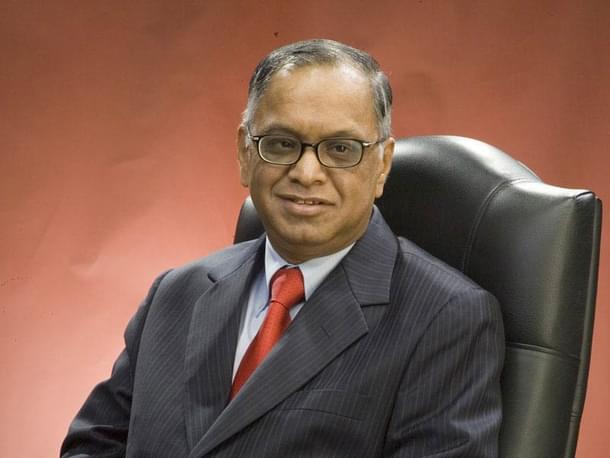Business
Narayana Murthy Vs Infosys Board: If One Had To Choose, Former Is The Lesser Evil
R Jagannathan
Aug 21, 2017, 10:43 AM | Updated 10:35 AM IST
Save & read from anywhere!
Bookmark stories for easy access on any device or the Swarajya app.


The current standoff between the board of Infosys, and its iconic founder, N R Narayana Murthy, does not look like ending well. The only way it can end without excessive damage to the company, its reputation and its investors is through a victory for Murthy, and the slow exit or reshaping of the current board.
Unfortunately, the board has made it harder to induct Murthy, even temporarily, by levelling serious allegations against him, and for holding him directly responsible for the exit of chief executive officer (CEO) Vishal Sikka. It has also indirectly ruled out his return. It said: “Given the commitment of the board to remain independent and pursue a chosen strategy, it currently has no intention of asking Murthy to play a formal role in the governance of the organisation.”
Murthy, who has hit back, has not covered himself with glory in the way he has chosen to highlight his concerns about falling governance standards in the Infosys board (mostly through leaks in the media), or by his claim that he is not chasing power or money. It is rather naïve of him to think that he can escape responsibility for Infosys’ problems by staying away from the solutions.
Here’s the bottomline: given the damaged credibility of the board, and the leadership vacuum created by Sikka’s departure by March 2018, only Murthy has the credibility to manage the interim. The only other person who can hold fort while Infosys transits to a new leadership is Nandan Nilekani, but from all accounts, he is unlikely to return. Even as Murthy raised a ruckus, Nilekani stayed away from any commentary on the company or the controversies it was enveloped in, even though he is one of its biggest shareholders. Nilekani shifted his personal priorities from corporate life to public policy after he left the company in 2009 to head the unique ID project of the United Progressive Alliance government.
With many US law firms threatening to file class action suits against Infosys for lack of transparency and causing losses to investors, the time window for action is narrow, and only Murthy is capable of stepping into the breach.
But before we come to that, a brief summation of why Infosys is in this mess – and how Murthy indirectly contributed to it – is useful.
Murthy’s main gripe with the Infosys board is not the business strategy pursued by Sikka, but its inability to rein him in and play the role of upholder of governance standards.
The matter came to a head when Sikka got the board to agree to purchase Panaya, in which a whisteblower alleged that the deal was done by Sikka without proper board approval, and also that the chief financial officer, Rajiv Bansal, was given a huge handshake, allegedly for keeping quiet on a deal he apparently opposed when he was in the company. Since the company paid six times Panaya’s annual revenues for the acquisition, the assumption is that Infosys overpaid for a company that was facing a downslide.
To still the criticism, the company got some reputed audit and law firms to vet the Panaya transaction and claimed that they had found nothing wrong, but Murthy’s counter is that if that is indeed the case, why not put the reports out in the public domain?
There can be a few reasons why the board is coy about putting these reports on its website: one, they do contain some damaging information on the board’s role in the deal, which might open it to lawsuits; two, there is confidential information which will damage its commercial interests in some way; or the CEO himself has been criticised for his role in the Panaya deal, which indirectly again shows up as a board failure. The Panaya deal and the reports commissioned by the board are likely to be key pieces of evidence in any lawsuit filed against the company.
A few tentative conclusions can be drawn from all the material available in the public domain so far.
First, the board of Infosys is inherently weak, especially after the departure of K V Kamath in 2015. His replacement, N Seshasayee, and the recently-inducted co-chair, Ravi Venkatesan, do not have sufficient ballast to manage both a powerful CEO and a determined founder like Murthy. While Seshasayee has been backed by the board, there are indications that this time the strong anti-Murthy statement issued by the board last Friday (18 August) was not unanimous.
Second, the departure of Murthy from the board in 2014, quickly followed by Kamath in 2015, left a huge board and governance vacuum at a time when a new CEO unschooled in the Infosys tradition was being inducted. Vishal Sikka’s success depended on having a strong board to both guide him and rein him in, especially since his entry was followed by a large number of exits from top management. It is fair to point out that some of the major exits had nothing to do with Sikka, and key personnel like Ashok Vemuri, board member and head of the Americas, left soon after Murthy returned to Infosys in 2013. It did not help that Sikka decided to base himself in the US, leaving the management of the second-rung and lower levels of leadership to others. The board should have insisted that Sikka operate from India most of the time, till the local leadership issues and operating norms were well established.
While it is not unusual to see high turnover in top management at a time of huge churn in the industry, especially given the need to drastically change the business model of the company in the face of weakening demand for traditional labour arbitrage services, the fact remains that Infosys did not manage the transition well.
The big question is: will the re-induction of Murthy for a third time help or make things worse?
The answer cannot be a clear yes or no, but it seems to be the least of all evils.
One, Murthy is the only one with the credibility to fix both the board and the succession. Two, he holds the India patent for corporate governance, and the company probably needs him to ensure that the class action suits don’t end up in eviscerating the company further. And three, given the second-rung leadership vacuum in Infosys, his entry will not be threatening to the third rung if new people, both old Infoscions and lateral inductions, are brought in to steady the ship.
Murthy would not have been required if the board had the necessary credibility to manage the transition smoothly. But that seems to be far from being the case.
We need both board and leadership changes at Infosys. Murthy seems the only one available to manage this dual transition. The company probably needs him for two more years – titles like Chairman Emeritus have been suggested by Mohandas Pai, a former CFO – while this change is put in motion again. The alternative is a sharp erosion in investor wealth, and a weak ability to face the lawsuits with equanimity.
Infosys does not have time on its hands. It could do worse than to ask Murthy to bail it out and steady the ship before exiting once more. At 71, Murthy does not seem to have lost his will to fight for his company. Maybe, it’s time to give him that chance.
Jagannathan is former Editorial Director, Swarajya. He tweets at @TheJaggi.





